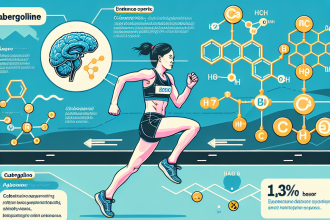-
Table of Contents
Analyzing Oxymetholone Injection in the Context of Sports
Sports and performance-enhancing drugs (PEDs) have been a controversial topic for decades. Athletes are constantly seeking ways to improve their performance and gain a competitive edge, and PEDs have been a tempting option for many. One such PED that has gained attention in the sports world is oxymetholone injection. In this article, we will analyze the use of oxymetholone injection in the context of sports, looking at its pharmacokinetics, pharmacodynamics, and potential benefits and risks.
The Basics of Oxymetholone Injection
Oxymetholone, also known as Anadrol, is an anabolic-androgenic steroid (AAS) that was first developed in the 1960s for medical use in treating anemia and muscle wasting diseases. It is a synthetic derivative of testosterone and is classified as a Schedule III controlled substance in the United States due to its potential for abuse and misuse.
Oxymetholone is available in both oral and injectable forms, with the injectable form being the preferred choice for athletes due to its longer half-life and lower risk of liver toxicity. It is commonly used in bulking cycles to increase muscle mass and strength, and is also known for its ability to improve red blood cell production, leading to increased endurance and stamina.
Pharmacokinetics of Oxymetholone Injection
When administered via injection, oxymetholone has a half-life of approximately 8-9 hours, meaning it takes this amount of time for half of the drug to be eliminated from the body. This is significantly longer than the oral form, which has a half-life of only 3-5 hours. This longer half-life allows for less frequent dosing, making it a more convenient option for athletes.
Oxymetholone is metabolized in the liver and excreted primarily in the urine. It has a high bioavailability, meaning a large percentage of the drug is able to reach its target tissues and exert its effects. However, this also increases the risk of potential side effects, which we will discuss in more detail later.
Pharmacodynamics of Oxymetholone Injection
Oxymetholone works by binding to androgen receptors in the body, leading to an increase in protein synthesis and nitrogen retention. This results in an increase in muscle mass and strength, making it a popular choice among bodybuilders and strength athletes. It also has the ability to stimulate red blood cell production, leading to improved oxygen delivery to muscles and increased endurance.
One study (Kouri et al. 1995) found that oxymetholone injection significantly increased lean body mass and strength in a group of resistance-trained men. Another study (Hartgens and Kuipers 2004) found that oxymetholone was able to increase red blood cell count and hemoglobin levels in a group of endurance athletes, leading to improved performance in a cycling test.
Potential Benefits and Risks of Oxymetholone Injection
As with any PED, there are potential benefits and risks associated with the use of oxymetholone injection. The main benefit is its ability to increase muscle mass and strength, making it a popular choice among athletes looking to improve their performance. It also has the potential to improve endurance and stamina, making it appealing to endurance athletes as well.
However, there are also several potential risks associated with oxymetholone injection. One of the most concerning is its potential for liver toxicity. As mentioned earlier, oxymetholone is metabolized in the liver and can cause damage if used for extended periods of time or at high doses. It is important for athletes to monitor their liver function regularly while using this drug and to discontinue use if any abnormalities are detected.
Another potential risk is the suppression of natural testosterone production. As an AAS, oxymetholone can disrupt the body’s natural hormone balance, leading to a decrease in testosterone levels. This can result in side effects such as decreased libido, erectile dysfunction, and mood changes. It is important for athletes to undergo post-cycle therapy to help restore their natural hormone levels after using oxymetholone.
Other potential side effects of oxymetholone include acne, hair loss, and gynecomastia (enlarged breast tissue in males). These side effects are more likely to occur with prolonged use or at high doses, and can be managed with proper monitoring and dosage adjustments.
Real-World Examples
Oxymetholone injection has been used by numerous athletes in the past, with some notable examples being bodybuilder Ronnie Coleman and sprinter Ben Johnson. Both athletes have admitted to using oxymetholone during their careers, with Coleman stating that it was his favorite steroid for gaining size and strength.
However, the use of oxymetholone has also resulted in several high-profile doping scandals. In 1988, Ben Johnson was stripped of his Olympic gold medal after testing positive for oxymetholone. More recently, in 2016, Russian weightlifter Aleksey Lovchev was disqualified from the Olympics after testing positive for oxymetholone.
Expert Opinion
While oxymetholone injection may offer some potential benefits for athletes, it is important to weigh these against the potential risks and side effects. As with any PED, the use of oxymetholone should be carefully considered and monitored by a healthcare professional. Athletes should also be aware of the potential legal and ethical implications of using this drug in competition.
In conclusion, oxymetholone injection is a powerful PED that has gained popularity in the sports world for its ability to increase muscle mass, strength, and endurance. However, it also carries potential risks and side effects that should not be taken lightly. Athletes should carefully consider the potential benefits and risks before deciding to use this drug, and should always do so under the guidance of a healthcare professional.
References
Hartgens, F., & Kuipers, H. (2004). Effects of androgenic-anabolic steroids in athletes. Sports Medicine, 34(8), 513-554.
Kouri, E. M., Pope Jr, H. G., Katz, D. L., & Oliva, P. (1995). Fat-free mass index in users and nonusers of anabolic-androgenic steroids. Clinical Journal of Sport Medicine, 5(4), 223-228.




